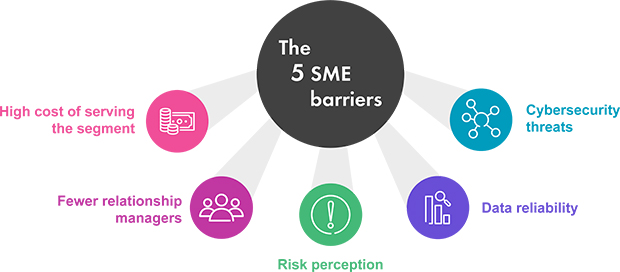Bridging the lending gap to empower SMEs

Industry experts recently came together with Finastra in London to discuss strategies for unlocking growth in SME and bilateral lending. In the first of a two-part article series, we share insights from the event – outlining the challenges facing SMEs and recommendations for boosting access to finance in support of growth.
Small and medium-sized enterprises (SMEs) are the backbone of the UK economy, contributing nearly 60% of GDP. Despite their economic importance, SMEs continue to face significant barriers when seeking finance, with traditional banking models struggling to adapt.
A fundamental misalignment exists between traditional lending practices and today's business realities. Banks historically focused on tangible assets as security, but as Martin McTague, National Chair of the Federation of Small Businesses (FSB), indicated: "We're now moving towards a service-based economy where there are fewer and fewer businesses with lots of tangible assets." This disconnect leaves many viable businesses unable to secure necessary funding despite their growth potential.
The sharp decline in overdraft facilities represents another critical challenge. Once the "bedrock of most borrowing for small businesses," overdrafts have become "virtually non-existent in a lot of banks," says Martin McTague. This reduction has severely impacted businesses' ability to manage cash flow fluctuations and working capital needs. With Allica Bank finding lending to small businesses has dropped by £90 billion since 2008 , the funding gap remains stark.
Personal guarantees and prohibitive interest rates further deter SMEs from seeking finance. According to the FSB Small Business Index, an alarming 60% of surveyed businesses refuse to take loans requiring personal guarantees, while 28% report paying interest rates exceeding 11% on term loans. As a result, these conditions create an impossible choice between growth and financial security.
Limited financial literacy compounds these challenges. "When you talk to most SME owners, there is only one financial facility they're aware of, and that's term loans," notes Martin McTague. Few understand alternatives like asset finance or invoice discounting, restricting their options to potentially unsuitable products. This knowledge gap prevents many from accessing more appropriate funding solutions.
The dominance of the Big Five banks in the UK has resulted in a generic approach to SME lending. As Eric Li, Head of Global Banking Research at Coalition Greenwich observed, "The cost of serving this segment is really high, particularly after the closure of many branches." This creates a mismatch between standardized bank offerings and diverse SME needs, opening opportunities for challenger banks and alternative lenders to bridge the gap with more tailored solutions.
Importance of government support and lending guarantees
As SMEs face persistent funding challenges, targeted government intervention and industry collaboration have become essential. The Growth Guarantee Scheme stands at the forefront of these efforts, although the volume of funding to UK businesses remains significantly smaller than for equivalent nations like Germany and the United States.
The British Business Bank has developed a comprehensive five-year strategy to address these gaps, as outlined by Thanasis Bakos, Director of Strategy and Policy: "We have put the Growth Guarantee Scheme on a permanent footing and are expecting £5 billion of lending to be supported over the next five years." The development bank is also increasing startup loans by a third, supporting community lending through a new £150 million Community Enable Funding Programme, and is expanding support for alternative lenders and challenger banks with flexible guarantee solutions.
Making a difference requires close collaboration between stakeholders. "Government working with lenders is the only way to address this," emphasized Thanasis Bakos. This partnership approach enables the development of flexible, risk-sharing structures that can better serve SMEs in underserved regions and sectors.
However, policy interventions alone won't close the gap without addressing financial literacy deficits. Industry players and business support organizations must prioritize financial education programs that build SME confidence and expand awareness of diverse funding options, empowering business owners to make informed financial decisions.
Overcoming operational and structural barriers

While government solutions aim to bridge the lending gap, incumbent banks face their own set of challenges in serving the SME market. Eric Li highlighted five persistent barriers: "The cost of serving this segment is really high, particularly after the closure of many branches," he explained. This cost issue, coupled with the reduction in relationship managers, has fundamentally altered how banks engage with smaller businesses.
Risk perception remains a significant hurdle. "Default rates in this segment tend to spike whenever there's a shock to the economy," notes Li. Despite resources like Companies House, data reliability continues to challenge lenders trying to assess SME creditworthiness accurately. Furthermore, growing cybersecurity threats can be a risk for SMEs that struggle to invest enough in this area.
Despite these challenges, Li observed that 2024 brought encouraging signs. After two and a half years of declining SME lending, volumes have begun to recover, increasing between 5% to 10% monthly. This uptick, driven by interest rate reductions and expanded guarantee schemes suggests the potential for a more supportive lending environment ahead.
Greater competition, public-private partnerships and the right technology can empower SMEs
Successfully bridging the SME lending gap requires a fundamental shift in how financial institutions engage with small businesses. At the heart of this transformation is rebuilding trust that was severely damaged during the financial crisis. "Being on the side of SMEs and them feeling that you're on their side... should be a given, but unfortunately, after the global financial crisis when banks withdrew their lending, a lot of businesses were treated badly," explained Conrad Ford, Chief Product Officer, Allica Bank.
Trust building begins with banks positioning themselves as partners rather than gatekeepers. Conrad Ford suggests that "a bank should think and act like an SME’s own in-house treasurer." This partnership approach extends to matching the entrepreneurial spirit of business owners with speed and certainty in decision-making. Decisions should take “one to two days, rather than six to eight weeks”, said Conrad Ford.
Technology and artificial intelligence are proving crucial in making this responsive approach economically viable. As Thanasis Bakos notes, technology can address some of the structural issues holding back SME lending. AI-powered analytics can streamline risk assessment, automate routine processes and enable personalized offerings at scale – yet technology must complement rather than replace human relationships.
Competition from alternative lenders is driving innovation across the sector. These new entrants have built business models specifically designed to serve SME needs with greater flexibility and understanding. Their success has pushed traditional banks to reconsider their approaches, creating a more dynamic marketplace that ultimately benefits small businesses.
Government involvement remains essential through enhanced funding regimes and flexible policy frameworks. The success of initiatives like the Growth Guarantee Scheme demonstrates how public-private partnerships can effectively share risk and extend credit to underserved segments.
Financial education represents the final critical piece of this puzzle. Greater awareness of diverse financing options and alternative providers will empower SMEs to make more informed decisions.
Ultimately, empowering SMEs requires a holistic approach that combines trusted partnerships, technological innovation, competitive markets, government support, and financial education. By addressing these interconnected elements simultaneously, the financial sector can close the lending gap and unleash the growth potential of small businesses that form the backbone of the UK economy.


